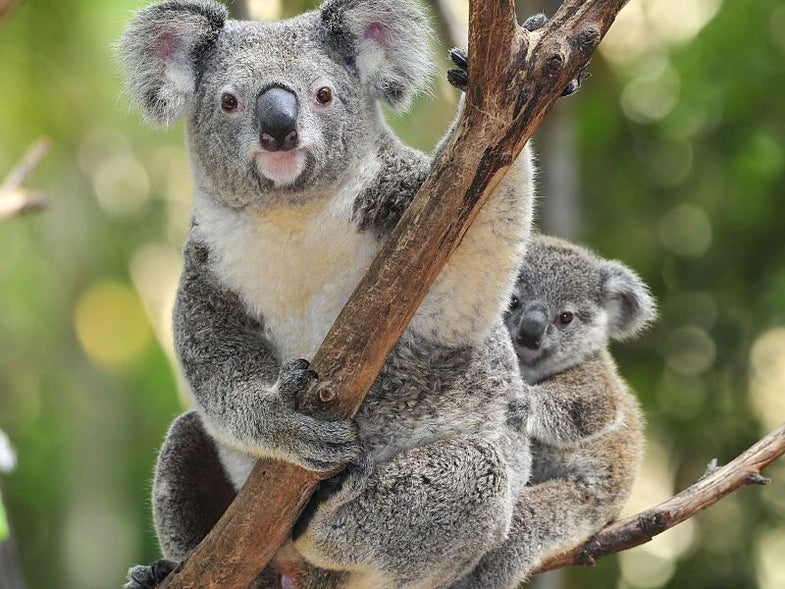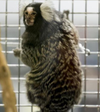_
Click to launch the photo gallery_
This week we found out that fruit flies can get depressed–in at least one experiment, anyway–after they realize they cannot escape uncomfortable heat no matter what they do. Depression is actually pretty common in the animal kingdom, especially when it’s induced in the lab. Many kinds of animals exhibit a classic depression-related sense of helplessness when they can’t change their situations.
But that led us to think about the other human ailments animals can become afflicted with. And they are many. We’re not talking about diseases that we induce for experimental purposes through genetic modification, from cancer to rats with Alzheimer’s–that’s a different story entirely. Symptoms like depression, however, or obesity, are ailments animals can contract on their own (or with some help from humans). These are illnesses we may not associate with other members of the animal kingdom.
Animals can also get sick with the same infections as humans. Flu and rabies are well known, but sexually transmitted diseases crop up in animals too. Animals can’t use protection to prevent STIs from spreading. Which critters contract venereal disease, as well as sicknesses of the respiratory tract, skin and cardiovascular system, may surprise you. Click through the gallery to see a few examples.
Hedgehogs Carry Salmonella
In January, the Centers for Disease Control and Prevention said these cuddly, adorable creatures are harbingers of a deadly form of salmonella. Apparently, since January 2012, the CDC has had been 20 reports of infections with a “historically rare” strain of salmonella, which appears linked to hedgehogs. Four people were hospitalized, a man in his 90s died, and almost half the people who fell ill were under 10 years old, according to NPR. Hedgehogs who carry the bacteria–one of the most common causes of food-borne illness–don’t seem sick, but they apparently transmit the bacteria through their poo. Let’s hope the person holding the hedgehog in this image washed her hands afterward, which apparently every hedgehog cuddler should do, the CDC said.
Badgers Can Get Tuberculosis
It’s a form that affects cows, but it’s the same mycobacterium that causes tuberculosis in humans. People used to be afflicted with Mycobacterium bovis, the cattle kind, but pasteurized milk has largely prevented that problem. Badgers have not been so lucky. Badgers can get TB and spread it to cattle, which then also get sick. This has led to controversial badger culling programs in the United Kingdom. Farmers have long blamed the striped European badger for sickening their cows, but until last fall, evidence of this was hard to come by. A study in PLoS Pathogens showed that tuberculosis-causing bacteria among four badgers and 26 cows in Ireland were almost indistinguishable from each other, showing a link between the two animals.
Armadillos Can Suffer From Leprosy
The scaly creatures can cause leprosy in humans, a disease which has otherwise mostly disappeared from Earth. Researchers with the National Institutes of Health showed in 2011 that some Americans contract the disease from contact with armadillos. The cases are concentrated in armadillo country in Texas and Louisiana, where people apparently hunt, skin and eat the animals. In some areas, about 20 percent of armadillos are infected with leprosy. The disease is characterized by skin lesions, and leads to nerve damage if untreated. Many other infections, from HIV to the flu, have jumped from animals into people. But leprosy is one of only a few that apparently went from us to them and back. As the New York Times pointed out, leprosy was not present in the New World until the arrival of European explorers 500 years ago, and armadillos are native to these parts. Scientists research leprosy using the lab mouse, which can contract leprosy on its foot pads, or with mice that have been genetically modified to contract the infection. But disease is so successful in armadillos that now they are sometimes used as model animals for studying it. Apparently the only organisms in which leprosy flourishes are us, and them.
Koalas Get Chlamydia
In humans, chlamydia causes a nasty venereal disease; in koalas, it is a killer. Infection with chlamydia is decimating koala populations in northeastern Australia, according to zoo surveys. Chlamydia has caused symptoms in about half of Queensland’s wild koalas, according to a report last year. The bacteria are transmitted during birth, through mating and possibly through fighting, according to the New York Times. It causes eye infections, which lead to blindness that prevents the animals from foraging; respiratory infections; cysts that lead to infertility; and other problems. Compounding matters is a widespread infection rate with koala retrovirus, like a form of HIV, which suppresses koala immune systems and makes the chlamydia even harder to fight. Researchers are working on a vaccine that could prevent the further spread of chlamydia.
Rabbits Get Syphilis
It is closely related to the same organism that causes syphilis in humans, but the rabbit form, Treponema paraluis cuniculi, can’t be spread to other animals or people. In rabbits, it breeds like rabbits, though. Rabbits spread syphilis, which is also called vent disease, through sexual contact and through birth, just like humans. They develop small genital ulcers, which eventually scab over. Also just like we can, rabbits can be treated with penicillin to eradicate the bacteria.
Dolphins Get HPV
Human papillomavirus is apparently common in Atlantic bottlenose dolphins, according to veterinarians from the Marine Animal Disease Lab at the University of Florida. It’s the first known natural model of the organism outside of humans. In humans, HPV is linked to cervical cancer in women, which is one reason there’s now a vaccine every girl should receive. But in dolphins, the virus apparently causes genital warts, not cancer. Further research into the virus’ genome could help scientists understand cervical cancer in humans.
Marmosets Can Become Obese Junk Food Addicts
Baby marmosets that were introduced to solid food at a young age are more likely to become obese, and to eat larger quantities of food if given the chance, according to a new study. This early-life obesity resulted in a host of metabolic changes, including insulin resistance, a hallmark of type 2 diabetes. “With its small size and early maturation, we think the marmoset is going to be an exceptionally good model of early life obesity and offers many opportunities to further explore why youngsters become obese,” said Suzette D. Tardif, associate professor of cellular and structural biology at the University of Texas-San Antonio School of Medicine. Tardif’s team had noticed obesity patterns began at a young age in these small monkeys, and wanted to test whether marmosets could become overweight by simply eating more. Tardif found that patterns leading to obesity begin very early in young marmosets, around 30 days of age. A month-old marmoset is equivalent to a 5- to 8-month-old human. The researchers monitored marmoset eating patterns and found that certain infants were prone to eating more. Marmosets have much less body fat than humans, but takes considerably less fat for marmosets to develop metabolic disorders like insulin resistance. Infants that became obese took bigger slurps at a lick device, and by the time they reached adolescence, they were already insulin-resistant. Marmosets can thus become helpful models for studying obesity in children, the researchers say.
Fruit Flies Can Feel Hopelessness
When they realize they cannot do anything to change a stressful situation, fruit flies under duress stop trying, according to new research. The fly slows down and exhibits listless behavior. “The fly copes with a stressful situation for which it has no ready-made answer in its behavioral repertoire,” according to scientists led by Martin Heisenberg of the Rudolf Virchow Center in Würzburg, Germany. This is related to depression, and could make flies a new animal model for studying depression-like symptoms.








